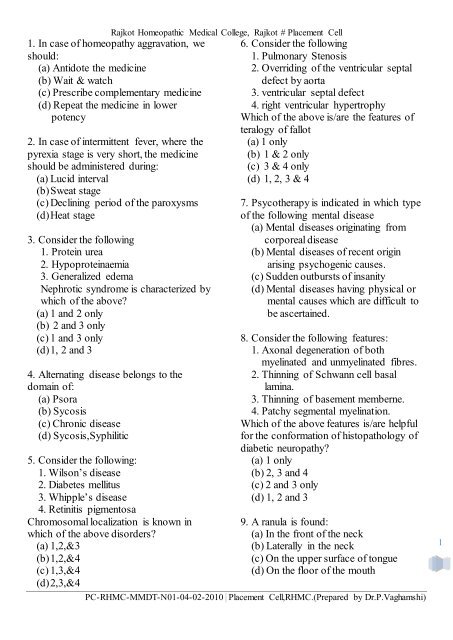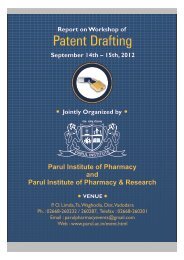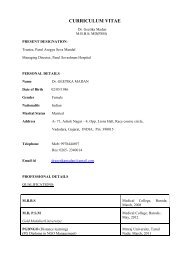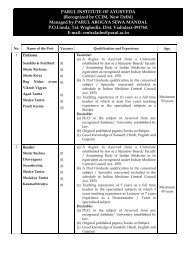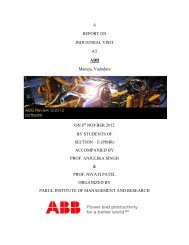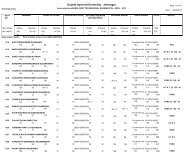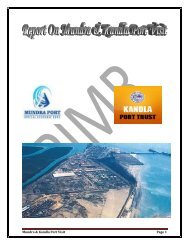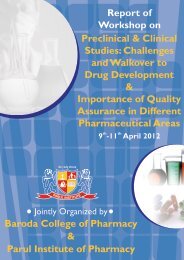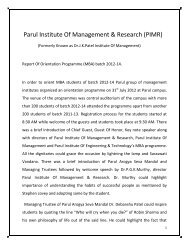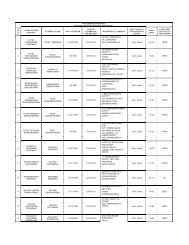MOCK HOMEOPATHIC MD ENTRANCE TEST(Sample Paper)
MOCK HOMEOPATHIC MD ENTRANCE TEST(Sample Paper)
MOCK HOMEOPATHIC MD ENTRANCE TEST(Sample Paper)
Create successful ePaper yourself
Turn your PDF publications into a flip-book with our unique Google optimized e-Paper software.
Rajkot Homeopathic Medical College, Rajkot # Placement Cell<br />
1. In case of homeopathy aggravation, we<br />
should:<br />
(a) Antidote the medicine<br />
(b) Wait & watch<br />
(c) Prescribe complementary medicine<br />
(d) Repeat the medicine in lower<br />
potency<br />
2. In case of intermittent fever, where the<br />
pyrexia stage is very short, the medicine<br />
should be administered during:<br />
(a) Lucid interval<br />
(b) Sweat stage<br />
(c) Declining period of the paroxysms<br />
(d) Heat stage<br />
3. Consider the following<br />
1. Protein urea<br />
2. Hypoproteinaemia<br />
3. Generalized edema<br />
Nephrotic syndrome is characterized by<br />
which of the above?<br />
(a) 1 and 2 only<br />
(b) 2 and 3 only<br />
(c) 1 and 3 only<br />
(d) 1, 2 and 3<br />
4. Alternating disease belongs to the<br />
domain of:<br />
(a) Psora<br />
(b) Sycosis<br />
(c) Chronic disease<br />
(d) Sycosis,Syphilitic<br />
5. Consider the following:<br />
1. Wilson‟s disease<br />
2. Diabetes mellitus<br />
3. Whipple‟s disease<br />
4. Retinitis pigmentosa<br />
Chromosomal localization is known in<br />
which of the above disorders?<br />
(a) 1,2,&3<br />
(b) 1,2,&4<br />
(c) 1,3,&4<br />
(d) 2,3,&4<br />
6. Consider the following<br />
1. Pulmonary Stenosis<br />
2. Overriding of the ventricular septal<br />
defect by aorta<br />
3. ventricular septal defect<br />
4. right ventricular hypertrophy<br />
Which of the above is/are the features of<br />
teralogy of fallot<br />
(a) 1 only<br />
(b) 1 & 2 only<br />
(c) 3 & 4 only<br />
(d) 1, 2, 3 & 4<br />
7. Psycotherapy is indicated in which type<br />
of the following mental disease<br />
(a) Mental diseases originating from<br />
corporeal disease<br />
(b) Mental diseases of recent origin<br />
arising psychogenic causes.<br />
(c) Sudden outbursts of insanity<br />
(d) Mental diseases having physical or<br />
mental causes which are difficult to<br />
be ascertained.<br />
8. Consider the following features:<br />
1. Axonal degeneration of both<br />
myelinated and unmyelinated fibres.<br />
2. Thinning of Schwann cell basal<br />
lamina.<br />
3. Thinning of basement memberne.<br />
4. Patchy segmental myelination.<br />
Which of the above features is/are helpful<br />
for the conformation of histopathology of<br />
diabetic neuropathy?<br />
(a) 1 only<br />
(b) 2, 3 and 4<br />
(c) 2 and 3 only<br />
(d) 1, 2 and 3<br />
9. A ranula is found:<br />
(a) In the front of the neck<br />
(b) Laterally in the neck<br />
(c) On the upper surface of tongue<br />
(d) On the floor of the mouth<br />
PC-RHMC-M<strong>MD</strong>T-N01-04-02-2010 | Placement Cell,RHMC.(Prepared by Dr.P.Vaghamshi)<br />
1
Rajkot Homeopathic Medical College, Rajkot # Placement Cell<br />
10. A 48 year old male who is known to be<br />
HIV positive has been admitted with<br />
high fever, headache, vomiting and<br />
drowsiness for the past seven days.<br />
The following tests were advised:<br />
1. CT of head.<br />
2. CSF serology.<br />
3. India ink preparation of CSF.<br />
Which of the above investigation would<br />
be helpful in establishing the aetiological<br />
diagnosis?<br />
(a) 1 and 2 only<br />
(b) 2 and 3 only<br />
(c) 1 and 3 only<br />
(d) 1, 2 and 3<br />
11. Match list I with list II and select the<br />
correct answer using the code given<br />
below the lists:<br />
List I List II<br />
(Symptom) (Medicine)<br />
A. Day time cough 1. Kreosotum<br />
B. Nocturnal enuresis 2. Apis Mel.<br />
C. 3 pm chilliness 3. Podophyllum<br />
D. 7 am fever 4. Ferrum Met.<br />
Paroxysm<br />
Code:<br />
A. B. C. D.<br />
(a) 4 2 1 3<br />
(b) 4 1 2 3<br />
(c) 3 2 1 4<br />
(d) 3 1 2 4<br />
12. Match list I with list II and select the<br />
correct answer using the code given<br />
below the lists:<br />
List I List II<br />
(Uncommon symptoms) (Medicines)<br />
A. Sensation as if drops 1. Petroleum<br />
of water falling from<br />
heart<br />
B. Sensation as if body 2. Sabadilla<br />
is light and flying in<br />
the sky<br />
C. Sensation as if she is 3. Can Sat.<br />
suffering from total<br />
throat cancer<br />
D. Sensation as if another 4. Lac Can.<br />
person is lying alongside<br />
him in the same bed<br />
Code:<br />
A. B. C. D.<br />
(a) 3 2 4 1<br />
(b) 1 4 2 3<br />
(c) 3 4 2 1<br />
(d) 1 2 4 3<br />
13. Which one of the following diseases<br />
have the characteristic features of<br />
„breathlessness (pulmonary congestion),<br />
fatigue, oedema, ascites (right heart<br />
failure), haemoptysis and signs of mitral<br />
facies mid-diastolic murmer and<br />
pulmonary hypertenstion‟?<br />
(a) Tricuspid regurgitation<br />
(b) Mitral stenosis<br />
(c) Mitral regurgitation<br />
(d) Atrial fibrillation<br />
14. Which one of the following types of<br />
disorders is Myasthenia Gravis?<br />
(a) Hereditary disorder<br />
(b) Autoimmune disorder<br />
(c) Involuntary muscle disorder<br />
(d) Metabolic disorder<br />
15. A 40 year old women complains of<br />
breathlessness and pain in chest on<br />
exertion, better by rest. Heaviness of feet<br />
by the evening. On examination, face has<br />
patches of dark pigmentation, conjunctivae<br />
pale, nails flattened and lusterless. All the<br />
complaints are getting progressively worse<br />
for last few months. If you are allowed<br />
only one investigation to clinch the<br />
diagnosis, which one of the following<br />
would you choose?<br />
(a) X-Ray chest<br />
(b) U/S abdomen<br />
PC-RHMC-M<strong>MD</strong>T-N01-04-02-2010 | Placement Cell,RHMC.(Prepared by Dr.P.Vaghamshi)<br />
2
(c) ECG<br />
(d) Haemogram<br />
Rajkot Homeopathic Medical College, Rajkot # Placement Cell<br />
16. Acute pain in right hypochondrium<br />
with vomiting, tenderness and rigidity<br />
may occur in:<br />
(a) Acute cholecystitis<br />
(b) Cholelithiasis<br />
(c) Acute hepatitis<br />
(d) II week of typhoid fever<br />
17. Which one of the following is the most<br />
common cause for „Spontaneous<br />
Pneumothorax‟ in India?<br />
(a) Rupture of a subpleural<br />
emphysematous bulla<br />
(b) Rupture of a subpleural tubercular<br />
focus into the pleural space<br />
(c) Rupture of a staphylococcal lung<br />
abscess<br />
(d) Bronchial carcinoma<br />
18. The „Trigger Zones‟ are the localized:<br />
(a) Hypoaesthetic spots on the face,<br />
gums or tongue<br />
(b) Hyperaesthetic spots on the face,<br />
gums or tongue<br />
(c) Slimy spots on the face, gums or<br />
tongue<br />
(d) Black spots on the face, gums or<br />
tongue<br />
19.‟Tingling in traches with cough‟ is a<br />
feature of:<br />
(a) Rumex<br />
(b) Stannum<br />
(c) Iodium<br />
(d) Sepia<br />
20. Consider the following statements:<br />
1. The human body has an excellent<br />
capacity to store vitamin B12.<br />
2. Milk is a good source of vitamin<br />
B12.<br />
Which of the statements given above is/are<br />
correct?<br />
(a) 1 Only<br />
(b) 2 Only<br />
(c) Both 1 and 2<br />
(d) Neither 1 nor 2<br />
21. Bronchiectasis is a condition of<br />
permanent abnormal dilatation of:<br />
(a) Alveolar sac<br />
(b) Large bronchii<br />
(c) Bronchioles<br />
(d) Lungs<br />
22. Which one of the following is not in<br />
the characteristic triad of manifestations<br />
in Reiter‟s syndrome?<br />
(a) Conjunctivitis<br />
(b) Tonsillitis<br />
(c) Arthritis<br />
(d) Urethritis<br />
23. Korsakoff‟s psychosis occurs in the<br />
deficiency of which one of the following?<br />
(a) Thiamin<br />
(b) Thyroxine<br />
(c) Pyridoxine<br />
(d) Vitamin K<br />
24. Cervical fibroid is commonly present<br />
with:<br />
(a) Menorrhagia<br />
(b) Retention of urine<br />
(c) Abdominal mass<br />
(d) Mass from vagina<br />
25. Tuberculosis of genital organs is more<br />
frequently seen in:<br />
(a) Fallopian tubes<br />
(b) Ovary<br />
(c) Uterus<br />
(d) Cervix<br />
26. Which part of the fallopian tube is the<br />
most common site for ectopic pregnancy?<br />
PC-RHMC-M<strong>MD</strong>T-N01-04-02-2010 | Placement Cell,RHMC.(Prepared by Dr.P.Vaghamshi)<br />
3
(a) Isthamic<br />
(b) Fimbrical<br />
(c) Interstitial<br />
(d) Ampllary<br />
Rajkot Homeopathic Medical College, Rajkot # Placement Cell<br />
27. Which one of the following is/are<br />
responsible for the proliferative phase of<br />
the menstrual cycle?<br />
(a) Oestrogen only<br />
(b) Oestrogen and progesterone<br />
(c) Progesterone<br />
(d) HCG<br />
28. Consider the following statements:<br />
Obesity is an important factor associated<br />
with:<br />
1. Insulin dependant diabetes mellitus<br />
2. Non-insulin dependant diabetes<br />
mellitus.<br />
Which of the statements given above is/are<br />
correct?<br />
(a) 1 only<br />
(b) 2 only<br />
(c) Both 1 and 2<br />
(d) Neither 1 nor 2<br />
29. Low backache and pain in lower<br />
abdomen in a patient of dysmenorrhoea are<br />
present in:<br />
(a) G.I.T.<br />
(b) G.U.T.<br />
(c) Reproductive organs<br />
(d) Surgical scars of abdomen<br />
30. Rectal bleeding in a child is likely to<br />
be:<br />
(a) Fissure<br />
(b) Polyp<br />
(c) Proctitis<br />
(d) Haemorrhoids<br />
31. Blood stained discharge from the<br />
nipple is typical of:<br />
(a) Intraductal papilloma<br />
(b) Fibroadenoma<br />
(c) Filarial mastitis<br />
(d) Paget‟s disease of nipples<br />
32. Klumpke‟s paralysis involves:<br />
(a) Lower trunk of brachial plexus<br />
(b) Upper trunk of brachial plexus<br />
(c) Total brachial plexus<br />
(d) Erb‟s point<br />
33. Meckel‟s diverticulam is a remnant of:<br />
(a) Mullerian duct<br />
(b) Vitellointestinal duct<br />
(c) Ductus venosus<br />
(d) Wolffian duct<br />
34. The most common site for an amoebic<br />
lesion in the bowel is:<br />
(a) Rectum<br />
(b) Sigmoid colon<br />
(c) Ascending colon<br />
(d) Transverse colon<br />
35. Osler‟s nodes are a clinical feature of:<br />
(a) Osteoarthritis<br />
(b) Rheumatoid arthritis<br />
(c) Leprosy<br />
(d) Infective endocarditis<br />
36. Which part of plant is used for the<br />
preparation of „Sabina‟?<br />
(a) Stem<br />
(b) Whole plant<br />
(c) Fruit<br />
(d) Bark<br />
37. Fluxion potency is a peculiar process<br />
when medicines prepared by Trituration<br />
are converted into potency by succession.<br />
What are the levels at which it is carried<br />
out?<br />
(a) 30 to 200<br />
(b) 2X to 4C<br />
(c) 6X to 8X<br />
(d) 12X to 14X<br />
PC-RHMC-M<strong>MD</strong>T-N01-04-02-2010 | Placement Cell,RHMC.(Prepared by Dr.P.Vaghamshi)<br />
4
38. Under which class (old method) is<br />
Aloes mother tincture prepared?<br />
(a) Class II<br />
(b) Class VI B<br />
(c) Class Vii<br />
(d) Class V A<br />
Rajkot Homeopathic Medical College, Rajkot # Placement Cell<br />
39. Match List I with List II and select the<br />
correct answer using the code given below<br />
the lists:<br />
List I List II<br />
(Haemoglobin) (Amount in blood)<br />
A. Hb in Male 1. 14-18 gm%<br />
B Hb in Female 2. 23 gm%<br />
C. Hb in newborn 3. 12.5 gm%<br />
D. Hb at the end of 4. 12-14 gm%<br />
one year<br />
Code:<br />
A. B. C. D.<br />
(a) 1 2 4 3<br />
(b) 1 4 2 3<br />
(c) 3 2 4 1<br />
(d) 3 4 2 1<br />
40. Which one of the following indicates<br />
the normal blood urea level?<br />
(a) 1 to 10 mg/dl<br />
(b) 15 to 40 mg/dl<br />
(c) 60 to 80 mg/dl<br />
(d) 100 mg%<br />
41. Match List I with List II and select the<br />
correct answer using the code given below<br />
the lists:<br />
List I List II<br />
(Disease) (Type of Anemia)<br />
A. Iron deficiency 1. Macrocytic<br />
anemia Normochromic<br />
B. Pernicious anemia 2. Macrocytic<br />
Hypochromic<br />
C. Aplastic anemia 3. Normocystic<br />
Normochromic<br />
Code:<br />
A B C<br />
(a) 2 1 3<br />
(b) 3 2 1<br />
(c) 3 1 2<br />
(d) 1 2 3<br />
42. Posterior pituitary secretes which of<br />
the following hormones?<br />
(a) ADH and Oxytocin<br />
(b) ACTH and LH<br />
(c) FSH and LH<br />
(d) TSH<br />
43. Markedly retarded growth, edema of<br />
legs, lethargy, dry brittle hair, with flag<br />
sign, distended abdomen are clinical<br />
features of:<br />
(a) Marasmus<br />
(b) Kwashhiorkar<br />
(c) Cretinism<br />
(d) Rickets<br />
44. Match List I with List II and select the<br />
correct answer using the code given below<br />
the lists:<br />
List I List II<br />
(Test) (Disease Condition)<br />
A. Casoni‟s Test 1. Plague<br />
B. Weilfelix 2. Infectiopus<br />
Rection Mononucleosis<br />
C. Ascoti‟s Test 3. Rickettsial<br />
Infection<br />
D. Paul Bunnel Test 4. Kala Azar<br />
Code:<br />
A. B. C. D.<br />
(a) 4 1 3 2<br />
(b) 4 3 1 2<br />
(c) 2 3 1 4<br />
(d) 2 1 3 4<br />
PC-RHMC-M<strong>MD</strong>T-N01-04-02-2010 | Placement Cell,RHMC.(Prepared by Dr.P.Vaghamshi)<br />
5
Rajkot Homeopathic Medical College, Rajkot # Placement Cell<br />
45. Allium Cepa is the vegetable analogue<br />
of :<br />
(a) Mag.Phos.<br />
(b) Arsenic Alb.<br />
(c) Phosphorus<br />
(d) Zincum Met.<br />
Direction:<br />
The following 3 (three) items consist of<br />
two statements: one labeled as the<br />
„Assertion (A)‟ and the other as „Reason<br />
(R)‟.You are to examine these two<br />
statements carefully and select the answer<br />
to these items using the code given below:<br />
Code:<br />
(a) Both A and R is individuallyTrue and R<br />
is the correct explanation of A.<br />
(b) Both A and R are individually true but<br />
R is not the correct explanation of A<br />
(c) A is true but R is false<br />
(d) A is false but R is true.<br />
46. Assertion (A): The pathognomonic<br />
symptom of cholera is copious rice watery<br />
stools.<br />
Reason (R): The pathogenesis of cholera is<br />
the inhibition of absorption of fluids in the<br />
small intestine.<br />
47. Assertion (A): Suppression of eczemas<br />
by local applications has been known to<br />
produce colitis, asthma and bronchitis.<br />
Reason (R): Psora is the mother of all<br />
chronic diseases.<br />
48. Assertion (A): Spongia is one of the<br />
best remedies for goiter.<br />
Reason (R): Spongia has proven precursor<br />
of thyroxin.<br />
49. Match List I with List II and select the<br />
correct answer using the code given below<br />
the lists:<br />
List I List II<br />
(Type of test) (Disease)<br />
A. Schick test 1. Tuberculosis<br />
B. Mantoux test 2. Typhoid<br />
C. Widal test 3. Syphilis<br />
D. Khan test 4. Diphtheria<br />
Code:<br />
A. B. C. D.<br />
(a) 3 1 2 4<br />
(b) 3 2 1 4<br />
(c) 4 1 2 3<br />
(d) 4 2 1 3<br />
50. Match List I with List II and select the<br />
correct answer using the code given below<br />
the lists:<br />
List I List II<br />
(Desires) (Drugs)<br />
A. Sweet 1. Hepar Sulph<br />
B. Salt 2. Antim T.<br />
C. Sour 3. Argent. Nit.<br />
D. Apple 4. Natrum Mur.<br />
Code:<br />
A. B. C. D.<br />
(a) 3 4 1 2<br />
(b) 2 1 4 3<br />
(c) 3 1 2 4<br />
(d) 2 4 1 3<br />
51.”Consolation aggravates” is not a<br />
symptom of which one of the following?<br />
(a) Sepia<br />
(b) Lilium Tig.<br />
(c) Slilicea<br />
(d) Pulsatilla<br />
52.“Great sadness and weeping, Dread of<br />
being of men; of meeting friends; with<br />
uterine troubles” is a symptom of which<br />
one of the following?<br />
(a) Sepia<br />
(b) Pulsatilla<br />
PC-RHMC-M<strong>MD</strong>T-N01-04-02-2010 | Placement Cell,RHMC.(Prepared by Dr.P.Vaghamshi)<br />
6
(c) Selenium<br />
(d) Aconite<br />
Rajkot Homeopathic Medical College, Rajkot # Placement Cell<br />
53. “Thirsty in dropsy. But thristless in<br />
fever” is a symptom of which of the<br />
following?<br />
(a) Acetic acid<br />
(b) Apis Mel<br />
(c) China<br />
(d) Pulsatilla<br />
54. Concordance Repertories are those:<br />
(a) Written in Prover‟s language<br />
(b) That does not have alphabetical<br />
arrangement of chapters and rubrics<br />
(c) That does not contain rubrics<br />
(d) Having a definite philosophical<br />
background<br />
55. Stammering is a rubric in which<br />
chapter of Kent‟s Repertory?<br />
(a) Larynx and trachea<br />
(b) Thorax<br />
(c) Mouth<br />
(d) Mind<br />
56. “Aversion to husband” is present in<br />
which chapter of Kent‟s Repertory?<br />
(a) Generalities<br />
(b) Female<br />
(c) Mind<br />
(d) Head<br />
57. The nerve supply to the deltoid muscle<br />
is by:<br />
(a) Circumflex nerve<br />
(b) Radial nerve<br />
(c) Median nerve<br />
(d) Ulnar nerve<br />
58. Coronary sinus opens into:<br />
(a) Left atrium<br />
(b) Right atrium<br />
(c) Right ventricle<br />
(d) Right lung<br />
59. Which one of the following eruptive<br />
fevers exhibits pleomorphism?<br />
(a) Small pox<br />
(b) Measles<br />
(c) Chicken pox<br />
(d) Allergic rash with pyrexia<br />
60. Toxic shock syndrome is caused by<br />
which one of the following?<br />
(a) Staphylococci<br />
(b) Pneumococci<br />
(c) Streptococci<br />
(d) Pseudomonas<br />
61. Consider the following statements:<br />
Babinski‟s sign is positive in a case of:<br />
1. Upper motor neuron lesion<br />
2. Lower motor neuron lesion<br />
Which of the statements given above is/are<br />
correct?<br />
(a) 1 only<br />
(b) 2 only<br />
(c) Both 1 and 2<br />
(d) Neither 1 nor 2<br />
62. What is the most common site of<br />
Kaposi‟s sarcoma in AIDS?<br />
(a) Lymph nodes<br />
(b) Stomach<br />
(c) Liver<br />
(d) Skin<br />
63. A tuberculosis patient could be<br />
infectious when he has:<br />
(a) T.B.meningitis<br />
(b) T.B. lymphadenitis<br />
(c) Pott‟s disease<br />
(d) Pulmonary T.B.<br />
64. Bitot‟s spots are caused due to the<br />
deficiency of:<br />
(a) Vitamin A<br />
(b) Vitamin D<br />
(c) Vitamin E<br />
(d) Biotin<br />
PC-RHMC-M<strong>MD</strong>T-N01-04-02-2010 | Placement Cell,RHMC.(Prepared by Dr.P.Vaghamshi)<br />
7
Rajkot Homeopathic Medical College, Rajkot # Placement Cell<br />
65. The name “50 Millesimal scale” was<br />
given by:<br />
(a) Hahnemann<br />
(b) Pierre Schmidt<br />
(c) Kent<br />
(d) Hering<br />
66. Logic of Homeopathy is based on:<br />
(a) Inductive method only<br />
(b) Both inductive and deductive<br />
methods<br />
(c) Deductive method only<br />
(d) Aristotle writings<br />
67. Only one wart on left index finger is<br />
a/an:<br />
(a) Internal one sided disease<br />
(b) External one sided disease<br />
(c) False chronic disease<br />
(d) Artificial chronic disease<br />
68. Where are intramural fibroid present?<br />
(a) Within the walls of uterus<br />
(b) In cervix<br />
(c) Outward of uterine surface<br />
(d) In the interior of the uterine cavity<br />
69. Consider the following:<br />
(a) Patient is intelligent and<br />
oversensitive<br />
(b) Silent type of patient who goes out<br />
and commits suicide<br />
(c) Sensitive to noise, to light and to<br />
odour.<br />
(d) All complaints are aggravated in<br />
winter.<br />
Which of the above symptoms are related<br />
to “Psoric Miasm”?<br />
(a) 1, 2 and 3<br />
(b) 1, 2and 4<br />
(c) 1, 3 and 4<br />
(d) 2, 3 and 4<br />
70. Among the following, the most<br />
common cause of maternal death in septic<br />
abortion is:<br />
(a) Endotoxic septic shock<br />
(b) Uterine perforation<br />
(c) Tetanus<br />
(d) Renal failure<br />
PC-RHMC-M<strong>MD</strong>T-N01-04-02-2010 | Placement Cell,RHMC.(Prepared by Dr.P.Vaghamshi)<br />
8


